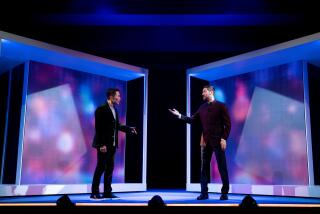It may be as storied as the city’s wind
- Share via
CHICAGO — You don’t have to live in Chicago to feel ripples from its theater scene. Just flick on the television, visit the local multiplex or plunk down the big bucks for a Broadway show.
There’s a good chance some of the actors, directors or scriptwriters learned their trade in a Chicago storefront or bus barn.
Where would television crime shows be without Chicago actors Dennis Franz (“NYPD Blue”), William Petersen (“CSI: Crime Scene Investigation”) or Gary Sinise (“CSI: New York”)? Dennis Farina was a real-life Chicago police detective before he became an actor and went on to play a New York police detective on “Law & Order.”
And while Laurie Metcalf, John Mahoney and David Schwimmer may have lost their sitcom homes (“Roseanne,” “Frasier” and “Friends,” respectively), they still return occasionally to the North Side theater companies where their careers began, as do film stars John Malkovich and William H. Macy.
Richard Christiansen remembers their first times around. After more than 40 years as a critic and arts writer, Christiansen, now retired, wrote “A Theater of Our Own: A History and a Memoir of 1,001 Nights in Chicago,” a 300-page history of Chicago theater published this fall by Northwestern University Press.
Christiansen remembers being so overwhelmed by Petersen’s 1983 portrayal of convicted killer Jack Abbott in “In the Belly of the Beast” that he had to stop his car and collect himself on the way to write his review. And he remembers Metcalf, Mahoney and Sinise in a 1980 Steppenwolf Theatre production of Lanford Wilson’s “Balm in Gilead,” directed by Malkovich.
“It was as if you were immersed with these characters in this diner,” Christiansen says.
Christiansen says Chicago’s tradition as a theatrical spawning ground goes back a long way -- back even before Chicago Yiddish theater star Muni Weisenfreund moved to Hollywood and became Paul Muni, or before Ben Hecht and Charles MacArthur celebrated their Chicago newspaper days in “The Front Page.”
Actor Brian Dennehy, who wrote the foreword to Christiansen’s book, devotes two pages to a bare list of notable Chicago theatrical names, and he doesn’t include some of the most famous, such as director Mike Nichols, who started in Chicago, or Orson Welles, who directed Shakespeare at the suburban Woodstock Opera House while still in his teens.
“It’s a crucible for theater,” Christiansen says. “A good actor can always find work here. He or she may not be able to earn a decent living, but they can always find work -- and learn the craft.”
The city’s long tradition of improvisational comedy helps, he says, by training actors and playwrights to think on their feet.
But that tradition dates only to the 1950s. Christiansen’s book begins in 1837, when some traveling players staged Chicago’s first legitimate theatrical show in the frontier town’s best hotel.
Christiansen writes about the early producers and theater owners and the touring stars they booked -- people like Joseph Jefferson, brothers Edwin and John Wilkes Booth, Sarah Bernhardt and Lillian Russell.
He chronicles the Iroquois Theatre fire of 1903, which killed some 600 people, and the Federal Theater Project of the Depression. But his narrative really hits its speed in the 1950s, when the city’s theatrical renaissance began and he started his career.
“I was young, and hungry and eager to find something to do, so I went off looking for small things,” says Christiansen, who joined the old Chicago Daily News in 1957 and retired from the Chicago Tribune in 2002. Those small productions, sometimes in converted Chinese restaurants or bowling alleys, included the Hull House Theater, the Second City comedy troupe and other innovative groups that were breaking theatrical molds.
There were only a few at first, but their numbers swelled in the 1960s and 1970s. The League of Chicago Theatres now boasts 156 member groups.
More to Read
The biggest entertainment stories
Get our big stories about Hollywood, film, television, music, arts, culture and more right in your inbox as soon as they publish.
You may occasionally receive promotional content from the Los Angeles Times.










